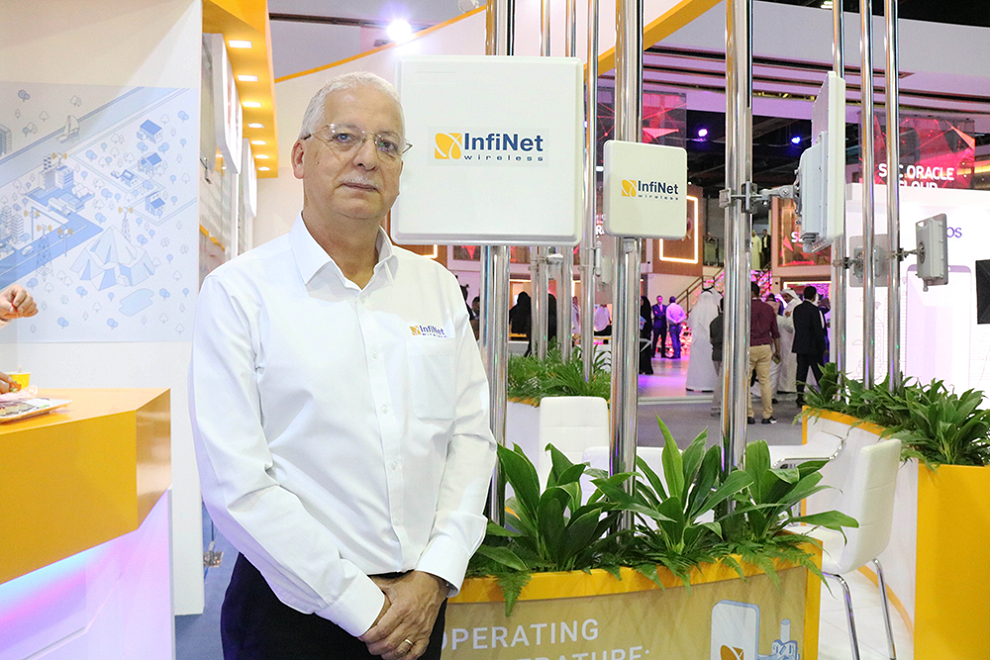Kamal Mokrani
Vice President at InfiNet Wireless speaks to Teletimes
Interview – Khalid Athar
Khalid Athar: Can you give us a quick overview of how 2018 was for InfiNet Wireless?
Kamal Mokrani: Thanks to our ongoing sales and marketing activities, coupled with the launch of some brand-new Software Defined Radio (SDR) product families, we have secured many new projects from all corners of the world during 2018. In particular, we have experienced significant growth from WISP’s wanting to migrate their legacy WiMAX deployments to more modern broadband infrastructures. In Africa, for example, InfiNet’s solutions have been largely deployed to bridge the digital divide between urban and rural communities.
We have also delivered multiple projects to the mining industry, for homeland security and border control, road and maritime traffic management, as well as for mobile operators looking to relieve their backhauling bottlenecks at the base station layer. We have delivered capacities of up to 1Gb/s, using less radio spectrum and achieving even lower latency, all at a very affordable cost.
Last year we grew our business by double digits and further strengthened our presence in key traditional markets such as the Middle East, Europe and Africa. We have also made major in-roads into emerging markets in Central and Latin America, as evidenced by the number of new projects won in various market sectors there. Finally, we have completed several multiple high-capacity projects for mobile operators in China, where our solutions have been deployed in extremely harsh environmental conditions and we have won against very stiff competition from lower-cost local vendors.
KA: What are the key challenges being faced by telecom companies today and what challenges do you foresee in the future?
KM: One of the major challenges operators face is around the adoption of 5G, as it relies entirely on the availability or freeing-up various chunks of the radio spectrum. There are many frequency bands between 3 GHz and 90 GHz being re-farmed by the ITU in general—as well as regulators in their respective countries―in order to achieve the performance targets expected from the 5G platforms. Freeing-up the required, but already scarce, radio resources are and will continue to be a real challenge for service providers of all types. Even if new 5G frequency bands have been identified and re-allocated, deploying the new infrastructure needed to deliver all future applications will require yet another massive investment by the telecom companies.
And it is not only about installing new equipment on existing towers or roof-tops. Using a radio spectrum in the 28 GHz, for example, will require a major increase in the density of the infrastructure, i.e. physical locations of so-called “small cells” which will need to be located nearer the end-users, every few hundred meters or so. Some service providers we talk to express doubts about the cost-effectiveness of such a model since they are not just looking at CAPEX for these new 5G bases stations, but also additional costs associated with backhauls and ongoing operational and maintenance costs.
KA: The introduction of “connected” devices in every area of life has revamped the telecommunications and ICT landscape. What is InfiNet Wireless doing to enable this “Internet of Things”?
KM: 5G and IoT are expected to be major game-changers for the next generation of technological platforms and associated applications and services. Their ultimate goal is to support the ever-increasing number of users by providing better speed, greater responsiveness, and connectivity to existing and future smart devices.
However, the requirements for managing such platforms in a cost-effective manner will create various new challenges. For instance, the need to support future and diverse applications will require higher capacity, more reliable connectivity, lower latency, access security, etc. All of these need tighter integration between the access platforms and the core and transport layers of a truly end-to-end and seamless fixed and mobile network.
At InfiNet, we recognised very early on that legacy cabled infrastructures can only take this technological revolution up to a certain point. Many of the unique selling points of IoT and 5G involve the necessary feature of mobility and hard-wired solutions will severely hamper the delivery of future applications and services. Wireless platforms, such as ours, present themselves as the ideal candidates for any service provider that is serious about deploying future 5G infrastructures.
Our long-term goal has always been to significantly boost population coverage of high-speed broadband, while at the same time minimising capital expenditure and unlocking additional value in the most cost-efficient way. Our ongoing dialogue with multiple stakeholders in the telecoms and ICT worlds gives our R&D teams the opportunities to understand their challenges, talk with like-minded experts and jointly contribute to the future of business and consumer communications As such we have become part of an open ecosystem that works together to realise these major game-changers.
KA: Please tell us a little about InfiNet’s Quanta and SDR technology.
KM: Software Defined Radio, or SDR, can be defined in multiple ways, depending on who you ask. For us, it simply means a wireless technology that enables us to meet changing needs of our markets and customers with mere software updates, i.e. where very little, if any at all, hardware changes will be needed to cater for future applications and services and where a network’s operation and parameters can be changed and enhanced post-manufacturing.
In all fairness, the concept of changing the characteristics of a wireless unit or network through software has actually been around for many years, and was initially developed for military applications. We have studied in great detail, learned from such concepts and have developed our SDR technology as a viable commercial platform for service providers wanting to deploy technological solutions that can adapt to ever-changing wireless standards and customer needs.
We have deliberately stayed focused on one of our core values, which is to design and deliver innovative wireless solutions, as evidenced by the recent launch of our new Quanta family of products, all based on our SDR platforms. Looking at it from a purely technical perspective, we have created a sustainable competitive advantage, offering new SDR solutions with major benefits to our end users, something other wireless vendors simply do not yet have. For example, we have optimized our underlying protocols and hardware platforms, which will deliver significantly higher capacity and performance, whilst requiring even less radio spectrum than is possible with today’s technologies, e.g. up to 1.2 Gb/s in only 40MHz of channel size. Our new generation of SDR solutions will enable us to make the next leap forward by delivering future-proof platforms with advanced capabilities to help address increasing customer demands, new IoT and 5G applications as well as new service trends. In summary, our new SDR architecture will significantly help transform how people use technology in their daily lives.
KA: What do you think will be the earliest and easily adaptable 5G use cases?
KM: The adoption of 5G is not going to be an easy walk in the park and is not going to happen overnight as many people tend to believe. It will take many years and will be one of the most complex and challenging infrastructure-related endeavours to be designed and built. Over time, all legacy networks will have no other option but to transition to a data-centric model, where major performance improvements, in all elements of the networks, will be desperately needed to deliver the required super-broadband connectivity. Wireless solutions such as InfiNet’s will certainly play a major role in the future of 5G and IoT.
The rationale for 5G has always been to overcome the known limitations of 4G, such as subscriber capacity and limited data rates, and at the same time, to add significantly more capability for current and future applications. The main use cases we foresee over the next 3 to 5 years will include delivering ultra HD 4K video streams to both mobile and fixed devices, fast and secure connectivity for the retail markets (e.g. shopping, banking, etc), even smarter cities, widespread virtual reality content and remote health monitoring. We also expect a major case linked with the automotive and communications arenas, especially as the driverless car concept gains momentum, attracts more investments and gets finally accepted even by the most sceptical among us.
KA: On a global level, which markets and vertical do you see as having the most potential for growth?
KM: We expect the wireless industry to continue its current growth trend over the foreseeable future and play an even bigger role in delivering the communication platforms of the future. On the IoT front, we see enormous potential for growing our company and we are playing a direct and active role in providing the required connectivity to end-users across the world. This is without doubt the biggest
area of potential growth for companies like ours, operating in the wireless sphere.
We will also continue to focus on improving our solutions in order to narrow the gap between the rural and urban districts of cities, as well as deliver even smarter public security and video surveillance platforms to ultimately reduce violent crime and improve the overall security and safety of citizens and entire communities. As an example, this latter market vertical is particularly important for us in countries such as Columbia, where rising crime rates continue to stretch police and government resources.
InfiNet is working very closely with the local authorities there to provide a state-of-the-art infrastructure to prevent drug trafficking and theft of remote government assets.
KA: What will be InfiNet Wireless’ major focus for 2019?
KM: Our plan for 2019, and beyond, is to further consolidate our global position by developing new wireless solutions, tailored to meet the exact requirements of our partners and end-users, wherever they are located, and in whatever market sector they operate.
This is indeed a strategic area of focus for our management team. Our aim is to enable seamless distribution and transport of content and applications by cooperating very closely with many of the big ICT and telecoms brands, to ultimately develop future-ready wireless solutions which will deliver advanced capabilities and benefits.
We believe firmly that our lives will need to be re-organised around the assumed existence of always-available and relevant information, which simply translates into the need for new technologies and more complex higher-order wireless infrastructures. Our current wireless solutions already enable devices of all types to seamlessly communicate with each another, but we intend to push physics to its limits and deliver even more than what was thought possible up to now.











